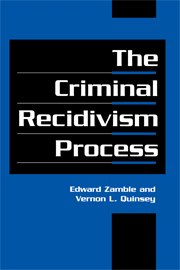Book contents
- Frontmatter
- Contents
- List of Illustrations and Tables
- Preface
- 1 Introduction: The Prediction of Criminal Behavior
- 2 The Study
- 3 Recidivists: A General Profile
- 4 Comparisons with Nonrecidivists
- 5 Comparisons across Offender Groups
- 6 Comparisons within Offender Groups
- 7 Final Considerations
- References
- Appendix: Interview Form
- Index
Appendix: Interview Form
Published online by Cambridge University Press: 02 February 2010
- Frontmatter
- Contents
- List of Illustrations and Tables
- Preface
- 1 Introduction: The Prediction of Criminal Behavior
- 2 The Study
- 3 Recidivists: A General Profile
- 4 Comparisons with Nonrecidivists
- 5 Comparisons across Offender Groups
- 6 Comparisons within Offender Groups
- 7 Final Considerations
- References
- Appendix: Interview Form
- Index
Summary
[this is the version used for recidivists; some questions differ for the control sample. A separate consent sheet contains the subject's name (with signature), FPS (RCMP identification number), and a subject number unique to the study; this is kept separately and securely, and subjects are identified in data files only by their study number.]
(Notes: Bridging dialogue is in italics, but questions are in normal text. Instructions are in parentheses. [Comments added for publication are in brackets.] Additional questions to clarify answers are always permissible. In general, answers should be recorded verbatim as much as possible, even if categories are supplied in the text, to allow later (re) categorization. However, the interviewer should keep possible categories in mind in seeking clarification.)
Introduction
As we explained before, what we are trying to do is to find out what is happening in men's lives while they are out on the street after being in prison. We are trying to find out what sorts of things happen before a new offence, so that in the future we might be able to predict recidivism or maybe even prevent it.
Given what we're interested in, you should be able to see why we're asking most of the questions that follow. If not, you can ask for an explanation, andI'll try to explain, although it may not be until we've finished the interview because it's very important that we finish in the time we have available.
- Type
- Chapter
- Information
- The Criminal Recidivism Process , pp. 163 - 178Publisher: Cambridge University PressPrint publication year: 1997



